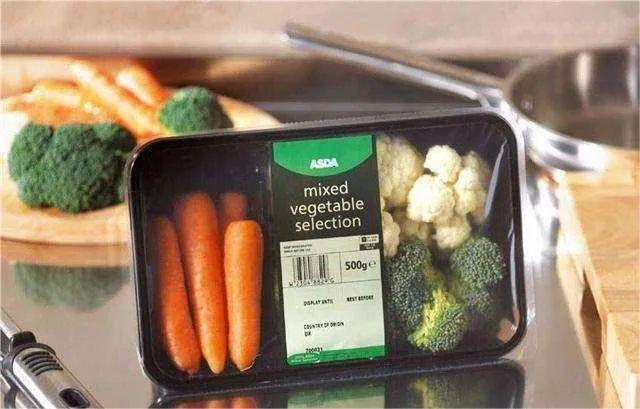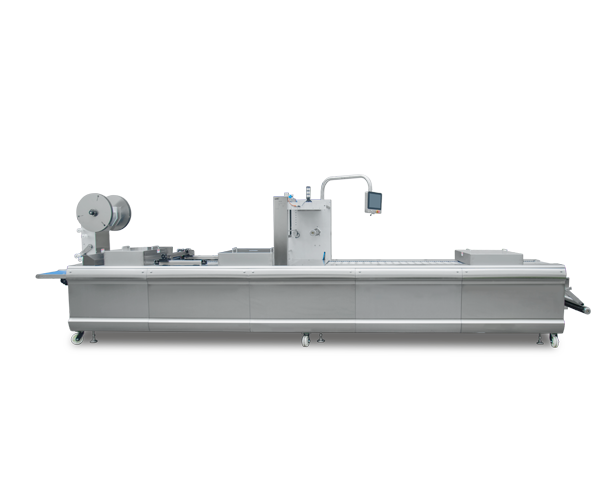A Modified Atmosphere Packaging (MAP) machine is a device designed to extend the shelf life of products by adjusting the composition of gases within the packaging. It is widely used in the food, pharmaceutical, and electronics industries. The primary function of MAP technology is to replace the air inside the packaging with a specific mixture of gases (such as nitrogen, carbon dioxide, and oxygen) to inhibit microbial growth and slow down oxidation processes, thereby maintaining the freshness and quality of the products. The application of MAP technology, especially in the food industry, significantly enhances product marketability and consumer satisfaction.
The core of MAP technology lies in gas replacement, where the air inside the packaging is removed and replaced with a specific mixture of gases to delay oxidation and microbial growth. Nitrogen is commonly used to replace oxygen because it is an inert gas that effectively prevents oxidation; carbon dioxide inhibits microbial growth; and oxygen is sometimes retained to preserve the color of fresh meat.
A MAP machine primarily consists of a vacuum pump, a gas mixing unit, and a sealing device. The vacuum pump removes the air inside the packaging, reducing the oxygen content. The gas mixing unit blends nitrogen, carbon dioxide, and oxygen according to preset ratios and injects the mixture into the packaging. The sealing device ensures the package is airtight, preventing external air from entering and maintaining the stability of the internal gas environment.

MAP machines can be classified into semi-automatic and fully automatic types based on the level of automation and operational mode.
Semi-Automatic MAP Machines
Semi-automatic MAP machines automate certain steps, such as gas replacement and sealing, but still require manual intervention for other steps. They are suitable for small to medium-sized businesses, offering a balance between efficiency and cost.
Fully Automatic MAP Machines
Fully automatic MAP machines handle the entire process from feeding to sealing autonomously, significantly improving production efficiency. These machines are ideal for large-scale production environments. They typically feature advanced control systems and sensors that monitor and adjust parameters in real time, ensuring high-quality packaging.
Modified Atmosphere Packaging (MAP) machines are versatile tools with a wide range of applications across various industries. Their ability to extend shelf life, maintain product quality, and reduce spoilage makes them invaluable in several sectors. Here, we explore the primary applications of MAP machines.
Food Industry
MAP machines have extensive applications in the food industry, particularly for perishable items like fresh meat, seafood, fruits, and vegetables. By adjusting the gas composition inside the packaging, MAP technology effectively extends the shelf life of these products. Additionally, MAP is used for pre-packaged, frozen, and ready-to-eat foods, maintaining their freshness and flavor and enhancing consumer appeal.
Pharmaceutical and Healthcare Products
In the pharmaceutical and healthcare industry, MAP technology plays a crucial role in extending the shelf life of medicines and health supplements. By controlling the internal gas composition, MAP can prevent moisture, oxidation, and microbial contamination, ensuring the safety and efficacy of the products.
Electronic Products and Industrial Parts
For certain electronic products and industrial parts, MAP can prevent moisture, oxidation, and rust, preserving product performance and quality. MAP technology is especially valuable for long-term storage and transportation, providing effective protection and reducing product losses.

Extending Shelf Life
One of the primary advantages of MAP machines is their ability to significantly extend the shelf life of food products. By altering the internal atmosphere of the packaging, MAP reduces the oxygen levels and increases the presence of gases such as nitrogen and carbon dioxide. This environment slows down the growth of aerobic bacteria and fungi, which are major contributors to food spoilage. This extended shelf life is particularly beneficial for fresh produce, meat, seafood, and dairy products.
Maintaining Freshness and Quality
MAP technology helps in preserving the freshness and quality of food products. By preventing oxidation and moisture loss, the color, texture, and nutritional value of the food are maintained over a longer period. For instance, fresh meat retains its red color, and fruits and vegetables remain crisp and vibrant. This quality preservation ensures that consumers receive products that look and taste as fresh as the day they were packaged.
Reducing the Use of Preservatives
Another significant advantage of MAP is the reduction in the need for chemical preservatives. As the modified atmosphere effectively slows down the growth of spoilage organisms, manufacturers can reduce or even eliminate the use of artificial preservatives. This aligns with consumer demand for cleaner labels and more natural products, contributing to a healthier diet and lifestyle.
Enhancing Market Competitiveness
Products packaged with MAP technology often have a competitive edge in the market. The extended shelf life and maintained quality allow for longer distribution chains and reduced waste, which is particularly beneficial for retailers. Moreover, the ability to offer fresher, preservative-free products enhances brand reputation and customer loyalty. This market advantage can translate into increased sales and market share.
MAP machine is a one-time asset investment, one of the most carefully decided upon of the entire project investment. Currently on the market a wide range of manufacturers of packaging machine, the specific choice of what kind of model, the need for more downstream demand, the general recommendation of the machine capacity to keep a certain margin.
Based on Product Type
Selecting the appropriate MAP machine starts with considering the type of product being packaged. Different products require different gas mixtures and packaging conditions. For example, fresh meat might need a higher concentration of oxygen to maintain its color, while bakery products might require more nitrogen to prevent spoilage. Understanding the specific needs of the product is crucial in choosing the right machine.
Packaging Speed and Production Efficiency
Another critical factor is the required packaging speed and production efficiency. High-volume production lines need fully automatic MAP machines that can handle large quantities quickly and efficiently. Conversely, smaller operations might benefit from semi-automatic or manual machines. Balancing the need for speed with production capacity helps in selecting a machine that fits operational requirements.
Cost-Benefit Analysis
Conducting a cost-benefit analysis is essential when investing in a MAP machine. This involves considering the initial investment, operational costs, and potential savings from reduced waste and longer shelf life. The analysis should also factor in the potential increase in sales due to improved product quality and marketability. A thorough cost-benefit analysis ensures that the chosen machine provides a good return on investment.
Maintenance and Upkeep
The maintenance and upkeep of the MAP machine are also important considerations. Machines that require frequent maintenance can lead to downtime and increased operational costs. Therefore, it is crucial to choose a machine that is reliable and comes with robust after-sales support. Regular maintenance schedules and easy-to-source spare parts can minimize disruptions and keep the machine running efficiently.
Modified Atmosphere Packaging (MAP) machines play a crucial role in modern industries by adjusting the gas composition inside packaging to extend the shelf life and maintain the performance of food, pharmaceuticals, and electronic products. By reducing oxygen levels and controlling other gases, MAP inhibits microbial growth and chemical reactions, preserving product freshness and quality. MAP technology enhances product market competitiveness and drives the packaging industry towards safer and more environmentally friendly practices.
By continuing to use the site you agree to our privacy policy Terms and Conditions.